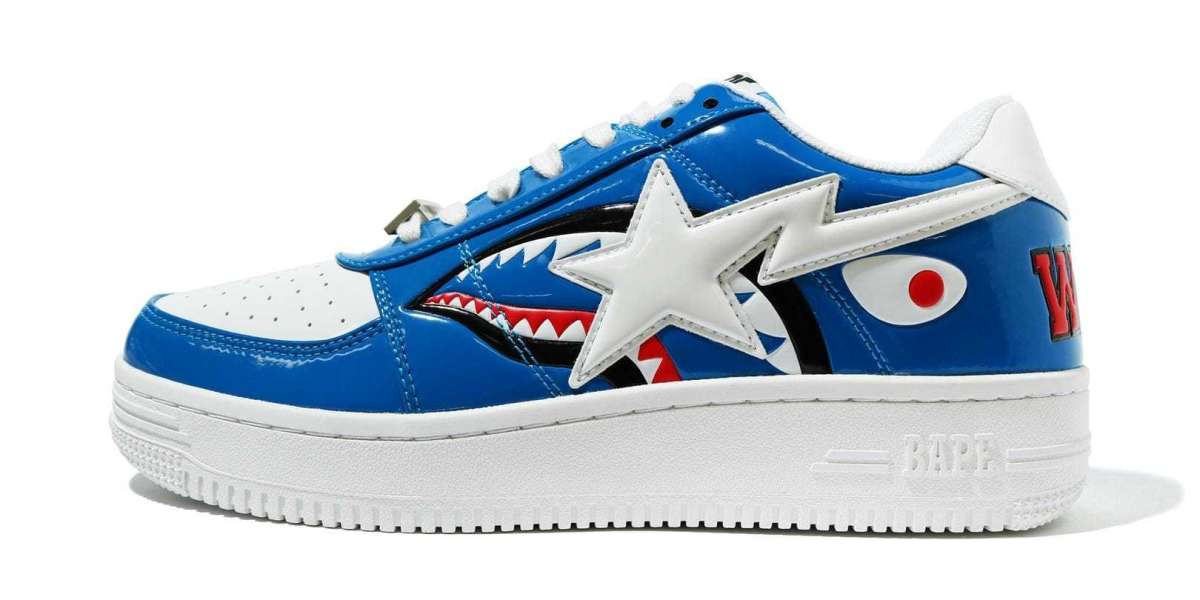The BAPESTA sneaker is not just a shoe—it’s a cultural phenomenon. Originally launched by A Bathing Ape (BAPE), a Japanese streetwear brand founded by Nigo in 1993, the BAPESTA gained worldwide fame for its bold colors, unique design, and unmistakable star logo. Modeled after the Nike Air Force 1 silhouette but reimagined with a flair unique to Japanese fashion, BAPESTA became a status symbol among hip-hop artists, sneakerheads, and fashion enthusiasts.
The Origin and Rise of the BAPESTA Sneaker
BAPE introduced the BAPESTA in the early 2000s, during a time when American hip-hop culture was heavily influencing Japanese youth. Nigo, already a style icon, saw the opportunity to combine Western design elements with Eastern street fashion aesthetics. He drew inspiration from Nike’s iconic silhouette and infused it with vivid colors, patent leather finishes, and the now-famous "STA" lightning bolt logo. The sneaker became an immediate hit, particularly in urban style circles where individuality and bold expression were highly valued.
Design Philosophy Behind the BAPESTA
One of the key features that sets the BAPESTA apart from other sneakers is its design philosophy. BAPESTAs are known for their vibrant, sometimes wild color schemes, including neon tones, camouflage patterns, and glossy materials. The star logo on the side panel adds a level of distinctiveness that is hard to ignore. Each pair is a statement, often reflective of pop culture, anime, or street art. This artistic fusion gives BAPESTA its appeal, merging fashion with contemporary cultural trends.
BAPESTA in the World of Hip-Hop and Celebrity Culture
The BAPESTA sneaker's popularity soared as it became a favorite among American rappers and celebrities. Icons like Pharrell Williams, Kanye West, Soulja Boy, and Lil Wayne frequently wore them, showcasing BAPESTAs in music videos, public appearances, and collaborations. Pharrell even went on to co-found Billionaire Boys Club with Nigo, further bridging the gap between Japanese and American streetwear. This endorsement from celebrities helped propel BAPESTA into the international limelight, cementing its place in hip-hop and fashion history.
The Impact of Limited Editions and Collaborations
Limited editions and special collaborations have played a significant role in keeping the BAPESTA brand relevant and desirable. Over the years, BAPE has partnered with renowned global brands and artists to release exclusive BAPESTA designs. These have included collaborations with Marvel, DC Comics, Adidas, Comme des Garçons, and even artists like Kid Cudi. Each drop sells out rapidly and often becomes a coveted collector’s item, maintaining the exclusivity and high resale value of the sneakers.
BAPESTA’s Influence on Global Sneaker Culture
The influence of the BAPESTA sneaker goes far beyond Japan or even the hip-hop community. It sparked a new wave of designer sneakers that embrace artistic creativity and cultural references. The trend of bold, unapologetic sneaker designs can be traced back to the popularity of the BAPESTA. Many brands have followed BAPE’s lead by producing vibrant, loud footwear that blurs the line between art and apparel. Streetwear, as a whole, became more expressive because of what BAPESTA stood for—fearless self-representation.
The Evolution of BAPESTA Through the Decades
Since its debut, the BAPESTA has undergone several design evolutions. From low-tops to high-tops, from suede to glossy leather, the brand has experimented with different styles and materials. Newer iterations have become more refined, with updated silhouettes, modern color palettes, and innovative construction methods. BAPE has remained agile, adapting to changing fashion tastes while still honoring the core elements that make BAPESTA iconic.
The Role of BAPESTA in the Resale Market
BAPESTAs are not just fashion statements—they are investment pieces. The limited nature of releases and the massive demand mean that prices on the secondary market often skyrocket. Some rare editions can fetch thousands of dollars. This has made BAPESTA a central figure in sneaker resale culture. Collectors hunt for vintage pairs, early 2000s editions, or rare collaborations, treating them as both fashion artifacts and high-value assets.
BAPESTA in the Digital and NFT Era
As streetwear brands explore the digital world, BAPE has shown interest in entering the metaverse and NFT spaces. This means we might soon see digital versions of BAPESTA sneakers being sold as non-fungible tokens or appearing in virtual fashion shows and online avatars. The BAPESTA brand is evolving with the times, ensuring that it remains a significant player in both the physical and digital worlds.
Future of BAPESTA: Innovation Meets Legacy
The future of BAPESTA lies in its ability to innovate while respecting its legacy. With a fan base that spans generations and continents, BAPE has the unique challenge of keeping its designs fresh without alienating long-time supporters. Sustainability, digital fashion, and tech integration could all play a part in the next chapter of BAPESTA sneakers. As trends continue to shift, one thing remains certain—the BAPESTA will continue to stand as a bold symbol of individuality, creativity, and cultural fusion.
Conclusion: Why BAPESTA Remains Iconic
The BAPESTA sneaker is more than a fashion item—it is a cultural statement, a work of wearable art, and a symbol of global streetwear evolution. From its roots in Tokyo’s underground to its rise as an international fashion icon, BAPESTA has consistently challenged norms and redefined what it means to wear sneakers with style and confidence













